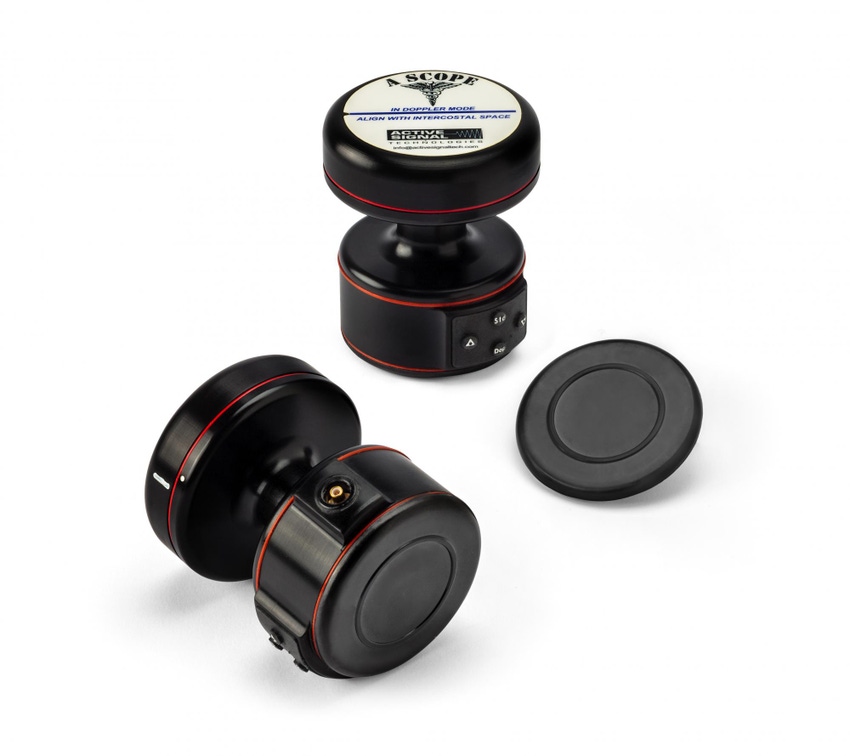A novel stethoscope using Doppler technology comparable to police radar is under evaluation by the U.S. Army as a way to save soldiers' lives on noisy medical evacuation helicopters.In normal stethoscopes, health care professionals listen to a patient's heart or lungs. They're useless when noise levels exceed 90 dBA. That's a problem for emergency medical personnel on helicopters and ambulances.
September 19, 2012

A novel stethoscope using Doppler technology comparable to police radar is under evaluation by the U.S. Army as a way to save soldiers' lives on noisy medical evacuation helicopters.
In normal stethoscopes, health care professionals listen to a patient's heart or lungs. They're useless when noise levels exceed 90 dBA. That's a problem for emergency medical personnel on helicopters and ambulances.
|
Critical component is made of Radel. |
The U.S. Army's Aeromedical Research Laboratory in Ft. Rucker, AL issued a request for a technical solution in an effort to save soldiers' lives.
A contract research firm in Linthicum Heights, MD, specializing in electromechanical devices went to work on the problem and developed a solution using a combination of sophisticated electronics, sensors, signal conditioning, and 2 MHz Doppler technology to detect physiologic activity. It is a self-contained handheld unit and can run for days without new batteries.
"We're not actually picking up sounds. And that's an important distinction," Arthur Cooke, president of Active Signal Technologies Inc., told PlasticsToday in an interview. After noise reaches a certain level, the A Scope developed by Cooke's company switches into a Doppler mode that detects motion of the lungs and the heart. It's a dual-mode stethoscope that also has a conventional electronic sound capability.
"In police radar you shoot a beam at a car and it gets reflected back with a high frequency if the car is coming fast towards you or not at such a high frequency if the car is going at the legal speed. We're detecting different frequencies depending on how the organ is moving."
One critical component in the device is a piece of engineering plastic that serves as the mounting surface for both the Doppler transceiver and the acoustic sensor. "The working end of both sensors rests on the front end of the device, which is made of Radel polyphenylsulfone resin from Solvay Specialty Polymers," said Cooke.
The two-inch wide, 0.10-inch thick part has reinforcing ribs and ultrasonically welded bosses around the circumference. The front face attaches to internal screws in the stethoscope's aluminum housing.
Polycarbonate was originally chosen for the part by Active Signal Technologies' design and manufacturing partner, Harbor Designs (Baltimore, MD). "It turned out we could not get polycarbonate with the same biocompatibility certifications that we could get for PPSU," said Cooke in the interview. The stethoscope's injection molded front flat face comes in direct contact with the patient's skin and bodily fluids.
A Solvay Specialty Polymers USA spokesman said that Radel PPSU also provides comparable toughness to polycarbonate and its chemical resistance enables the device to withstand harsh medical substances including cleaning agents, alcohol, and chlorinated solvents.
The device has passed a comprehensive series of MIL-STD 810F environmental tests; is FDA approved (510(k)—Number K103499); and was deployed to Afghanistan for field evaluation in late 2011.
Cooke's company has shipped 100 of the devices to the Army, including 25 that were part of a field evaluation by an Army Field Assistance in Science and Technology, or FAST, team.
For the time being the military is expected to be the primary user of the A Scope because of the need to confirm vital signs during aeromedical evacuation in the presence of high background noise. Other uses could follow if civilian users can discover medical applications for the Doppler returns. Its high price and requirement for advanced training may be deterrents, however.
Active Signal Technologies was founded in 1996 by the core members of the advanced sensor and solid state actuator group at Lockheed Martin's corporate lab in Baltimore, MD.
You May Also Like



